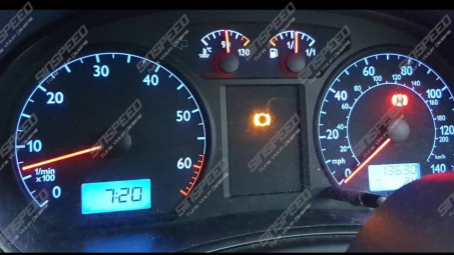The instrument cluster, or dashboard display, is a critical component in every vehicle. It provides real-time information about speed, fuel levels, engine temperature, and system warnings.
When the cluster malfunctions, drivers may face inaccurate readings, warning light failures, or even complete display blackouts. Understanding the common causes of car cluster failure is essential to prevent issues, maintain safety, and ensure smooth vehicle operation. Timely attention to these causes can help prolong cluster life and maintain accurate vehicle monitoring. 1. Electrical Issues Electrical problems are among the most frequent causes of cluster failure: Blown fuses – Can disable specific gauges or the entire dashboard. Faulty wiring – Loose, frayed, or corroded wires can disrupt signals from sensors to the cluster. Short circuits – May cause flickering displays, erratic readings, or complete failure. Regular inspections of vehicle wiring and fuses help prevent these electrical failures from affecting the cluster. 2. Faulty Gauges or Mechanical Components Analog clusters rely on mechanical components to move needles and display information: Worn gears – Speedometer and odometer gears can wear out, causing inaccurate readings or stuck needles. Mechanical failure – Needle arms or linkages may break or misalign over time. Mechanical failures often develop gradually, so early signs like lagging or erratic needle movements should be addressed promptly. 3. Software or Calibration Errors Modern vehicles with digital dashboards depend on software to process and display information: Software glitches – Can cause displays to freeze, flicker, or show incorrect readings. Calibration errors – Improper calibration during installation or maintenance can lead to inaccurate speed, fuel, or temperature data. Professional calibration and software updates are crucial to prevent and correct these issues. 4. Exposure to Heat and Humidity Clusters are sensitive to environmental conditions: Excessive heat – Can damage electronic circuits, backlighting, or LCD screens. High humidity – May cause condensation inside the cluster, leading to short circuits or corrosion. Protecting the vehicle from extreme conditions and keeping the cabin climate-controlled helps extend cluster life. 5. Water or Liquid Damage Spills or leaks can severely impact clusters: Liquid ingress can corrode electronic boards. Short circuits from moisture can lead to flickering or total failure. Condensation from leaks may cause long-term damage if not addressed promptly. Avoid placing liquids near the dashboard and address leaks immediately to prevent cluster damage. 6. Age and Wear Like any vehicle component, clusters degrade over time: Backlighting bulbs may dim or burn out. Electronic components may fail due to prolonged use. Analog parts, such as gears and needles, can wear out. Regular inspection and preventive maintenance can help mitigate age-related failures. 7. Poor Installation or Previous Repairs Clusters that have been removed or repaired improperly may experience recurring issues: Loose connectors or misaligned gauges can cause erratic behavior. Improper software updates may lead to glitches or calibration errors. Unskilled repairs may damage delicate electronic components. Always seek professional cluster repair to ensure proper handling, installation, and calibration. 8. Vibration and Impact Vehicle vibrations or impacts can damage cluster components: Off-road driving or poor road conditions – Can loosen connections or damage mechanical parts. Minor collisions – Even low-speed impacts can misalign internal cluster components. Minimizing harsh driving conditions and inspecting the cluster after collisions helps prevent failures. 9. Battery and Power Supply Problems A stable power supply is essential for cluster functionality: Weak or failing battery – May cause flickering or incomplete gauge readings. Alternator issues – Voltage fluctuations can damage electronic circuits in digital clusters. Maintaining a healthy battery and electrical system supports reliable cluster operation. Preventive Measures to Reduce Cluster Failure Understanding these causes allows drivers to take proactive steps: Regular inspections – Monitor gauges, warning lights, and displays for irregular behavior. Electrical system checks – Test fuses, battery, and wiring connections periodically. Avoid harsh conditions – Protect the vehicle from extreme heat, humidity, and liquid exposure. Professional repairs and calibration – Ensure any cluster issues are handled by qualified specialists. Prompt attention to anomalies – Address flickering, stuck needles, or warning light failures immediately. Preventive care reduces the likelihood of total cluster failure and ensures accurate vehicle monitoring. Professional Cluster Repair Clusters combine mechanical, electronic, and digital components. Attempting DIY repairs can worsen problems, cause calibration errors, or damage delicate circuits. Always find a specialist near you for professional cluster repair. Experts can diagnose electrical or mechanical issues accurately, perform proper calibration, and restore full functionality, prolonging the life of your instrument cluster. Conclusion Car cluster failure can stem from multiple sources, including electrical issues, mechanical wear, software glitches, environmental exposure, improper repairs, vibration, and power supply problems. Recognizing these common causes allows drivers to take preventive measures, maintain accurate readings, and ensure vehicle safety. Timely car cluster repair addresses underlying issues, restores gauge and warning light functionality, and prevents small problems from escalating into major failures. By understanding and addressing the causes of cluster failure, drivers can maintain a safe, reliable, and efficient vehicle. A well-maintained instrument cluster is not just a convenience—it is a critical component for safe and confident driving.







